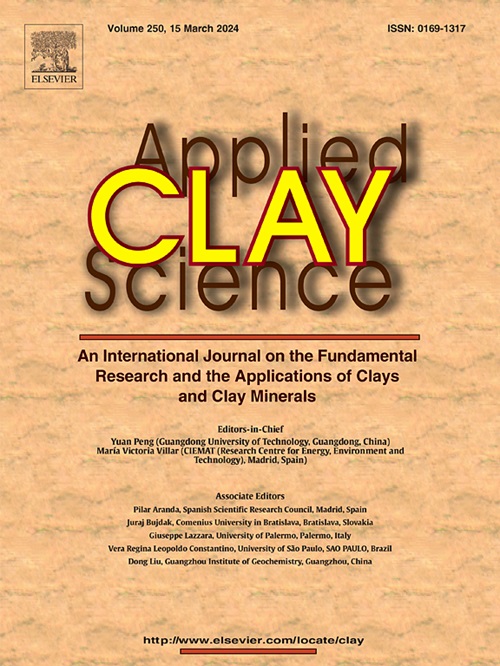Cronstedtite: H2 generation and new constraints on its formation conditions
IF 5.3
2区 地球科学
Q2 CHEMISTRY, PHYSICAL
引用次数: 0
Abstract
This work investigated the formation conditions of cronstedtite, the most Fe-rich serpentine, using a steel autoclave lined with Teflon at 90 °C, over 167 days, allowing for in situ monitoring of pH, T and P, as well as for gas sampling. From a starting mineralogical mixture composed of quartz and metal iron, cronstedtite crystallized in association with, magnetite, akaganeite, ferrihydrite and amorphous silica. This mineralogical association was not observed in previous syntheses and it is likely related to the experimental conditions of this study. These conditions also affected the composition and structure (polytypic sequence and crystallinity degree) of cronstedtite, which are accurately characterized for the first time. Experimental data and thermodynamic modelling indicate that this Fe-serpentine formed under neutral conditions, -62 < logfO2 < −59, and redox potential ranging from −0.46 to −0.41 Volts. During the experiment, H2 was generated by iron oxidation in presence of water, explaining the increase of pressure in the autoclave until 6.8 bar at 90 °C. The total amount of H2 generated was of 0.23 mol. The results of this study are useful to improve the understanding of cronstedtite formation in natural and anthropic environments. They also showed that formation conditions of cronstedtite seem to be compatible with those needed for hydrogenotrophic life, as previously supposed by other works.
克朗斯梯特:H2 生成及其形成条件的新制约因素
这项研究利用一个内衬特氟隆的钢制高压釜,在 90 ° C 的温度下,历时 167 天,研究了最富含铁的蛇纹石--川长石的形成条件,从而对 pH 值、T 值和 P 值以及气体采样进行了现场监测。在由石英和金属铁组成的初始矿物混合物中,铁石棉与磁铁矿、赤铁矿、铁水合物和无定形二氧化硅结晶在一起。这种矿物关联在以前的合成中没有观察到,可能与本研究的实验条件有关。这些条件还影响了芒硝的组成和结构(多晶序列和结晶度),并首次对其进行了精确表征。实验数据和热力学模型表明,这种铁蛇纹石是在-62 < logfO2 < -59的中性条件和-0.46至-0.41伏的氧化还原电位下形成的。在实验过程中,铁在水中氧化产生了 H2,这也是高压釜中的压力在 90 °C 时上升到 6.8 巴的原因。产生的 H2 总量为 0.23 摩尔。这项研究的结果有助于人们更好地了解自然和人为环境中铜闪石的形成。研究结果还表明,芒硝的形成条件似乎与之前其他研究推测的养氢生命所需的条件相符。
本文章由计算机程序翻译,如有差异,请以英文原文为准。
求助全文
约1分钟内获得全文
求助全文
来源期刊

Applied Clay Science
地学-矿物学
CiteScore
10.30
自引率
10.70%
发文量
289
审稿时长
39 days
期刊介绍:
Applied Clay Science aims to be an international journal attracting high quality scientific papers on clays and clay minerals, including research papers, reviews, and technical notes. The journal covers typical subjects of Fundamental and Applied Clay Science such as:
• Synthesis and purification
• Structural, crystallographic and mineralogical properties of clays and clay minerals
• Thermal properties of clays and clay minerals
• Physico-chemical properties including i) surface and interface properties; ii) thermodynamic properties; iii) mechanical properties
• Interaction with water, with polar and apolar molecules
• Colloidal properties and rheology
• Adsorption, Intercalation, Ionic exchange
• Genesis and deposits of clay minerals
• Geology and geochemistry of clays
• Modification of clays and clay minerals properties by thermal and physical treatments
• Modification by chemical treatments with organic and inorganic molecules(organoclays, pillared clays)
• Modification by biological microorganisms. etc...
 求助内容:
求助内容: 应助结果提醒方式:
应助结果提醒方式:


